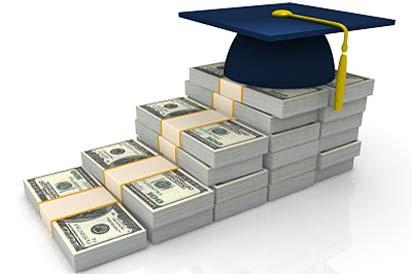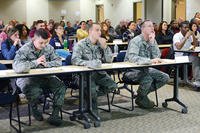The U.S. Department of Education announced today that the official three-year federal student loan cohort default rate has declined to 13.7 percent for students who entered repayment in FY 2011. That drop was across all sectors of higher education - public, private and for-profit institutions – even though an additional 650,000 students entered repayment in FY 2011 compared to FY 2010.
The default rate for FY 2010 was 14.7 percent.
"While it's good news that the default rate decreased from last year, the number of students who default on their federal student loans is still too high, and we remain committed to working with postsecondary education institutions and borrowers to ensure that student debt is manageable," said Secretary of Education Arne Duncan. "The Department will continue our efforts to help borrowers by providing more flexible repayment options and better counseling and information. We will also continue working with institutions to ensure they are providing their students with the information and guidance the students need to repay their loans after they graduate."
The Department has undertaken several new initiatives to help borrowers manage their debt and repay their loans. To help borrowers understand their loan obligations, the Department has introduced tools, such as thefinancial aid counseling tool, and provided extensive financial aid information on StudentAid.gov, including details on flexible loan repayment plans. These plans allow borrowers to repay their loans based on their income. Borrowers who need assistance in repaying their federal student loans can also contact the holders of their loans to learn about repayment options.
In June, as part of a broad effort to lift the burden of student loan debt, President Obama directed Secretary Duncan to allow all federal student loan borrowers to cap their monthly payment amounts at 10 percent of the borrower's monthly income. The Department has begun to put the President's directive into effect, with the goal of making the new plan available to borrowers next year. The Department is also using innovative communication strategies this fall to help inform borrowers of their repayment options, especially when they run into difficulty managing their student loan payments. Thanks to a wide variety of outreach efforts, more than 2.5 million Direct Loan borrowers are currently enrolled in an income-driven repayment plan.
In addition, the Department has recently renegotiated terms of the federal student loan servicer contracts to create additional incentives for companies that service federal student loans to improve counseling and outreach to ensure borrowers select the repayment plan best-suited to their financial circumstances, reduce payment delinquency and help borrowers avoid default. The Department is also taking steps to address growing concerns about burdensome student loan debt by requiring career colleges to do a better job ofpreparing students for gainful employment.
Breakdown of Cohort Default Rates by Institution Type
The default rates announced today were calculated using the cohort of borrowers who entered repayment on their Direct Loans or FFEL Program loans between October 1, 2010 and September 30, 2011 and who defaulted before September 30, 2013. During this time, more than 4.7 million borrowers entered repayment, and about 650,000 defaulted on their loans. These borrowers attended 5,908 postsecondary schools across the country.
The three-year rate decreased over last year's rates for all sectors, decreasing from 13 percent to 12.9 percent for public institutions and from 8.2 percent to 7.2 percent for private non-profit institutions. The default rate decreased at for-profit institutions from 21.8 percent to 19.1 percent, though the sector still has the highest three-year rate.
Sanctions
The Higher Education Opportunity Act of 2008 amended the Higher Education Act to require that, starting this year, sanctions against institutions with high cohort default rates be based on the three three-year cohort default rates. Congress changed the calculation of the cohort default rate to include an additional year of monitoring to better capture the percentage of borrowers who ultimately default on their federal student loans.
In preparation for this transition from the two-year calculation to a three-year rate, over the past five years, the Department has provided institutions with three-year cohort default rates going back to FY 2005 so colleges and universities were aware of their performance under the revised calculation. The Department has also worked with all institutions, to support them during the phase-in of the new rate.
Schools with high default rates may lose eligibility to participate in one or more federal student aid programs. This year, one adult and continuing education school and 20 for-profit schools are subject to loss of eligibility for default rates that either were 30 percent or greater for three consecutive years, or was more than 40 percent for the latest year, or both. These schools face loss of eligibility in for the federal student aid programs unless they submit successful appeals to the Department. The list of institutions subject to sanction is provided below.
"I encourage institutions that may be subject to sanctions to communicate with their students to ensure that they understand the implications of a potential loss of access to federal loans," Duncan said.
All institutions with a default rate that is equal to or greater than 30 percent must establish a default prevention task force that prepares a plan to identify the factors causing the school's cohort default rate to exceed 30 percent and submit the plan to the Department.
The Department's Federal Student Aid office provides extensive assistance to higher education institutions, including webinars and online training; state, regional and national association training forums, and face-to-face training events.
Information on the national student loan default rate, as well as rates for individual schools, states, types of postsecondary institutions and other details, are available here.
List of institutions subject to loss of eligibility sanctions:
Merrillville Beauty College
Henri's School Of Hair Design
American Commercial College
Ohio State College Of Barber Styling
Manhattan Beauty School
Charleston School Of Beauty Culture
Guti, The Premier Beauty And Wellness Academy
Tidewater Tech
Aaron's Academy Of Beauty
Ventura Adult And Continuing Education
L T International Beauty School
Florida Barber Academy
Aviation Institute Of Maintenance
Jay's Technical Institute
Memphis Institute Of Barbering
Northwest Health Careers
Eclips School Of Cosmetology And Barbering
Palladium Technical Academy
Coast Career Institute
San Diego College
Rwm Fiber Optics





